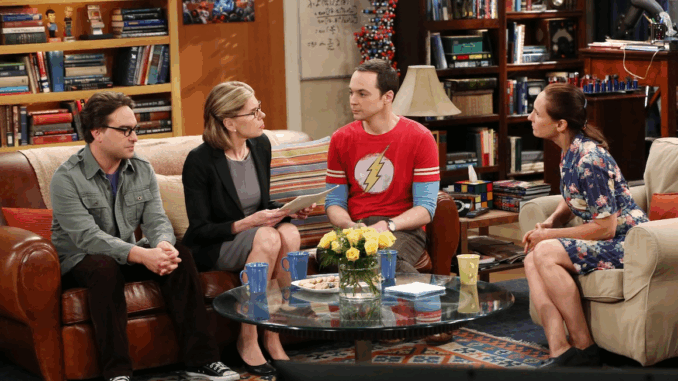
An Iconic Malfunction That Defined the Series
In the twelve-season run of The Big Bang Theory, few recurring jokes became as beloved—or as symbolically rich—as the out-of-order elevator in the apartment building where Leonard, Sheldon, and Penny live. It’s just a broken elevator, right? Not quite. Like many brilliant aspects of this show, the elevator that never worked wasn’t just a running gag; it became a subtle metaphor for growth, struggle, and the unpredictable nature of life.
Each time the characters trudged up and down the stairs, often panting and bickering, the elevator silently framed their journey—not just vertically, but emotionally and relationally. As the show evolved, the elevator became a symbol of how hard-earned progress truly is.
More Than Just Broken: The Elevator as a Symbol of Stalled Growth
From the very first episode, viewers are introduced to the elevator’s condition: permanently broken. This forces the characters to take the stairs, which in sitcom terms offers countless opportunities for awkward small talk, comedic arguments, and spontaneous moments of bonding. But beneath the humor lies a message: growth doesn’t come easy.
For Sheldon, Leonard, Howard, and Raj, the daily climb symbolizes more than just physical effort. It represents their ongoing efforts to navigate adult life, relationships, and their own emotional challenges. While they are all brilliant scientists with lofty ideas, the reality of life—like the stairs—is slow, repetitive, and sometimes exhausting.
Staircase Conversations: Where Comedy and Vulnerability Collide
Some of the show’s most heartfelt moments occur in the stairwell. That long walk between floors serves as neutral ground—a place where the characters aren’t confined by their apartments or labs, but where they’re caught mid-journey, often metaphorically as much as literally. Whether it’s Leonard gathering the courage to tell Penny how he feels, or Sheldon spiraling into one of his existential rants, these in-between spaces give the characters a place to reflect and confront their inner worlds.
The broken elevator, in this context, becomes an unspoken prompt—forcing them to move, to talk, and to grow. Without it, many of the intimate conversations that define character arcs might never have happened. The act of walking those stairs became a crucible where vulnerability met humor.
Sheldon and the Elevator: A Moment That Defined a Friendship
In one of the most emotionally impactful moments of the series—Season 3, Episode 22, “The Staircase Implementation”—the origin of the broken elevator is finally revealed. It wasn’t a simple maintenance issue. Instead, it was a life-threatening incident that Sheldon heroically averted when Leonard’s experimental rocket fuel exploded.
That single event reframes everything. Viewers realize that Sheldon, often portrayed as cold and lacking empathy, risked his life to save his roommate. It was a rare glimpse into the depth of Sheldon’s loyalty, tucked behind his obsessive-compulsive quirks. The elevator, since then, stands not only as a symbol of broken machinery but also of a repaired relationship—a bond forged in crisis and cemented over the years.
The Long Climb to Maturity and Connection
For a show obsessed with comic books, The Big Bang Theory cleverly mirrors one of the most persistent superhero tropes: the origin story. Just as Batman’s trauma led him to fight crime or Spider-Man’s bite defined his path, the characters’ continual climb up those stairs mirrors their journey from boys to men—from emotionally stunted geniuses to grown individuals capable of love, compassion, and self-awareness.
Think of Howard, who starts as an immature flirt and becomes a loving husband and father. Or Raj, who overcomes his crippling social anxiety. Leonard and Penny’s relationship evolves from awkward neighbors to a complex but enduring marriage. And even Sheldon—perhaps the one who changes the most—learns to accommodate, empathize, and commit.
And all of this happens, literally and figuratively, step by step.
When the Elevator Was Fixed: A Bittersweet Milestone
In Season 12, Episode 16, “The D & D Vortex,” the elevator is finally repaired—nearly twelve years after its first appearance. For many fans, it was a bittersweet moment. The elevator’s resurrection marked the end of an era, a sign that the characters had arrived somewhere after years of emotional climbing.
Interestingly, when Penny tries to take the elevator, Sheldon still opts for the stairs. Change, as we’ve learned through this symbolic prop, is slow and often resisted. But the moment is poignant—it shows that while growth happens, our habits and comfort zones don’t vanish overnight.
Conclusion: Climbing Higher with Every Step
The elevator that never worked in The Big Bang Theory may seem like a simple gag to the untrained eye, but for longtime fans, it was a structural and emotional backbone. It reminded us that progress isn’t about shortcuts or convenience. It’s about trudging forward, even when it’s hard. It’s about conversations mid-journey, about facing challenges together, about becoming more than who we were.
In fixing the elevator at the end of the series, the writers offered viewers a final message: we’ve all come a long way. And like Leonard, Sheldon, Penny, and the rest of the gang, sometimes the most important moments happen not at the top, but on the stairs between.

